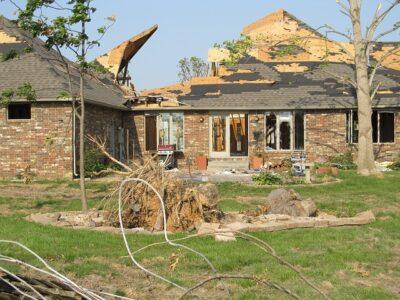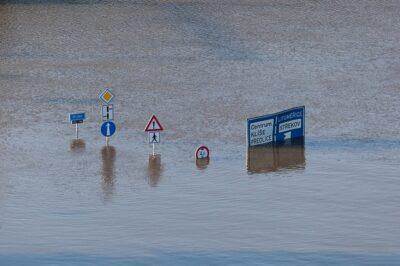|
Listen To The Article
|
Most of us are planning on “bugging in” when a disaster strikes. Generally speaking, that’s a much more practical solution for people who don’t have a survival retreat off in the woods somewhere. Not only does your home provide you with shelter, but it has all of your survival equipment and supplies, as well as your other possessions. But what do you do if something happens to your home?
There is always a risk of your home taking a hit during a natural or man-made disaster. Some disasters, like earthquakes and tornadoes, have a clear reputation for destroying houses. If that should happen to you, then you will need an instant replacement. If you haven’t thought about it beforehand, then you might not have an idea of where to go or what to do.
To start with, evaluate the condition of your home. If part of it is still standing, then you might be able to take shelter there, at least on a temporary basis. You only want to do this if the part that is standing is structurally sound, though. If it is likely to fall, you don’t want to be trapped inside.
If you find that you have to abandon your home during a societal collapse, there are a number of places around you, many of which may very well be excellent shelters to use. While they may not be as nice to stay in as your home, neither is a makeshift shelter or a tent off in the woods somewhere.
1. Outbuildings
If you have outbuildings on your property, that might be a good starting point. Surprisingly, a shed or detached garage might survive a situation in which the house is destroyed. While that building may not be as well constructed as the home was, it might have been sheltered by the home itself.
Granted, a shed or garage isn’t a very comfortable or even nice place to lay your head to rest. Nonetheless, it has the advantage of being close to your home. That means you can stay close to your possessions. If you are going to begin salvage operations — to get what you can out of your damaged home — then it helps to stay close. Besides, you should be able to use those salvaged items to make your temporary shelter more comfortable.
2. Your Place Of Business
If you own a business, then you probably have an alternate shelter that you have legal title to, even if you rent it. Your office or store may very well survive something that damages your home. This is simply because commercial buildings are often stronger than residences. Their simpler construction, lack of windows and need to support more weight on the floor leads to a more robust building design.
If you have such a place, it would be good to stock some emergency supplies and equipment there, so that in the case of a disaster, it’s easy to move your family to the workplace. While you probably won’t want to abandon the equipment and supplies you have at home, what you keep at your business will help your family to survive while you are salvaging whatever you can.
3. Abandoned Homes
Whatever makes your home uninhabitable may make it so that many other people flee. If that happens, then there will probably be a good assortment of abandoned homes available in the neighborhood. (Note: Use this option only as a last resort in a societal collapse.) The problem with this is that you would technically be trespassing and if the person came back, the situation could become a bit sticky. For this reason, I wouldn’t be too quick to move into someone else’s home.
If forced to move into someone else’s home, it is wise always to treat it as if it were theirs and not mine. In other words, I would take care of their home, leaving their possessions alone as much as possible. While I would use their furniture and kitchenware, I wouldn’t remove anything from their home or rearrange things any more than absolutely necessary. That way, if they were to come back, I could at least show that I’ve cared for their home.
Having said that, moving into an abandoned home is probably the most comfortable option you have for an urban survival shelter in an emergency situation. While it wouldn’t be your home, it would be a home with all the comforts you could expect.
Build Your Very Own Backyard Survival Bunker!
4. An Abandoned Business
There are always abandoned buildings around that were once stores, warehouses, and other businesses. Any of these provide the basics necessary for a shelter. They can keep the weather out and protect your family. At the same time, businesses usually have a lot of open space, which you can configure as you need for your family. They also often have bathrooms, which might still work if there is water service.
While I wouldn’t hesitate to use an abandoned business as a survival shelter, I wouldn’t expect much more of it than it to be something to help protect me from the weather. I would operate under the assumption that anything I need would have to be brought in.
One nice thing about abandoned businesses is that you can pre-plan. Just by keeping your eyes open for businesses that close in your area, you can know which businesses would be available in the case you need an emergency shelter. A little further investigation could show how you can get into those buildings if you have to use them as a shelter.
5. A Vehicle
This may sound a bit unusual, but survival situations are unusual. A vehicle can actually be a fairly good, although small shelter, in times of need. I lived in a motorhome for a number of years, traveling the country. Although the space was limited, I had everything I needed. In a pinch, I could have lived in a much smaller vehicle if needed.
A prepared vehicle is easier to live in. But even if your vehicle isn’t prepared ahead of time, there are things you can do to make it work. Adding a shell to the back of a pickup or removing the back seats from a van creates a living space. A mattress in that area makes a comfortable sleeping area. Camping equipment, such as a camp stove, can quickly turn that makeshift vehicle shelter into something rather comfortable and workable.
6. An Abandoned Basement
Basements are the part of any structure that are most likely to survive. As such, they can be used as a place of refuge, even when the rest of the building has been destroyed. Often, the floor above the basement will remain intact even when the rest of the building is destroyed. That can turn the basement into an underground home.
During World War II, much of Europe was destroyed. As the various armies battled across the landscape, defenders would take refuge in buildings, using them as makeshift pillboxes. The attackers then had to destroy those buildings, clearing out the soldiers. The residents of those buildings often took refuge in the basement.
While a basement isn’t a very comfortable shelter, it worked for the Europeans. At a minimum, it protected many of them from being killed by shrapnel and gunfire. Once the fighting moved on, many stayed in the basements because the houses and apartments above were destroyed. While it wasn’t as comfortable as home, it was still shelter.
7. The Underground
Speaking of basements, underground structures of many types have been used as shelters at one time or another. The catacombs of France are probably the most famous of these. But those aren’t the only underground shelters that have been used. Governments often build underground bunkers to hide activities, simply because they are well hidden.
Of course, you won’t be able to get into an underground bunker that the government is using, but many cities nevertheless have some sort of underground. This could be a storm sewer system (like the catacombs) or a subway system. Some cities even have commercial areas that are underground. Regardless of why the structure is underground, it is much more likely to survive many a calamity than anything above ground is. That makes it possible to use as an emergency shelter.
What type of shelter would you use? Share your tips in the comments section below:
 Off The Grid News Better Ideas For Off The Grid Living
Off The Grid News Better Ideas For Off The Grid Living






